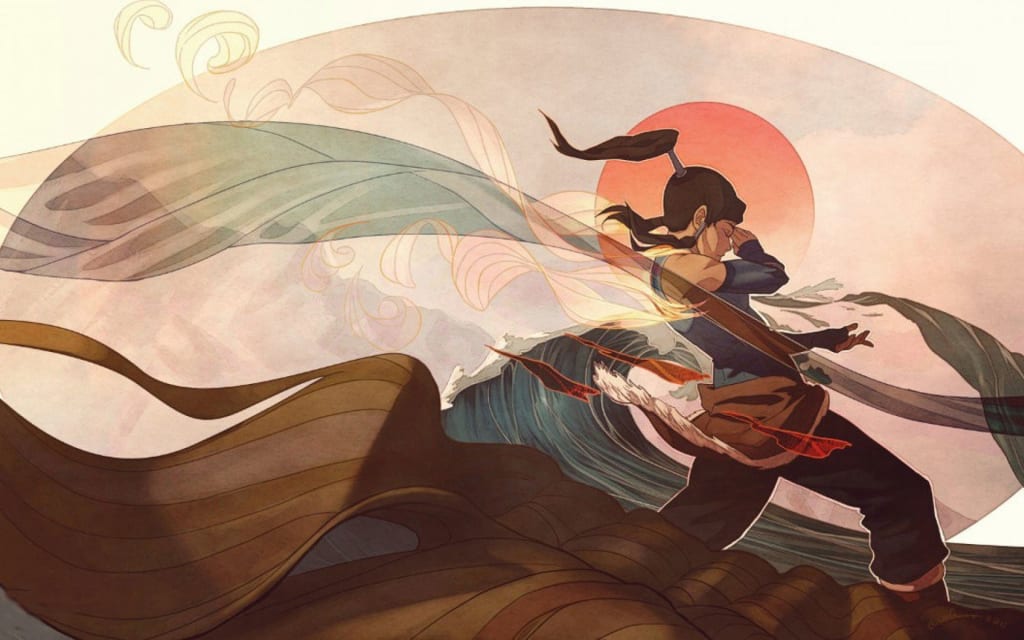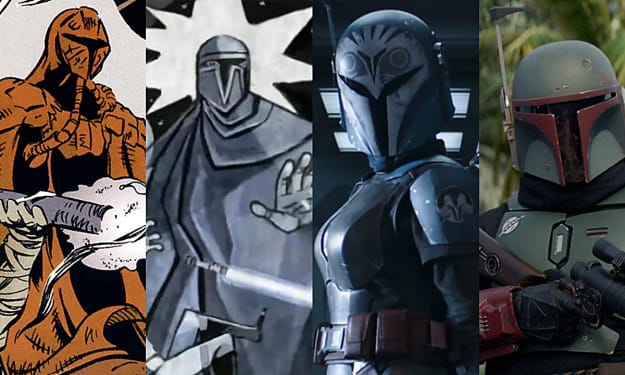Sexuality In The Legend of Korra
How the LGBTQ themes of Legend of Korra changed children’s animated television forever.

Children’s television has advanced far beyond the innuendos of 80s Saturday morning cartoons like He-Man and G.I. Joe, programs that were rife with homoerotic interactions and inconsequential violence. The Nickelodeon animated series, The Legend of Korra, is a prime example of a show that defied the trappings of conventional kid’s programming while maintaining a sense of realism and a stance against ambiguous portrayals of female characters, diversity, death, and romance.
While many American-produced cartoons struggle to depict girls as anything more than one-dimensional sidekicks to male protagonists, The Legend of Korra featured a groundbreaking heroine whose ambiguous ethnicity added to the allure of the alternate universe where a single person, known as an Avatar, could manipulate the four elements of air, earth, water, and fire. Korra is a strong-willed, seventeen-year-old Avatar who develops an endearing friendship with industrialist Asami Sato, which later leads to a budding romance. As revealed in the finale of the program, Korra and Asami grew closer emotionally through their gal-pal adventures, making The Legend of Korra the first major western animated series to feature a confirmed LGBTQ relationship.
Continuing the Progressive Themes of Avatar: The Last Airbender
Launched in 2012 as a sequel to Avatar: The Last Airbender, The Legend of Korra struggled to find a fit within the constraints of child-friendly TV, with its broadcast lasting a mere two years before it was relegated to an online-only slot on Nick.com. During a packed panel at 2014 San Diego Comic-Con, series co-creators Michael Dante DiMartino and Bryan Konietzko attempted to explain the shift from Friday night primetime to streaming but diehard fans. Many of these fans were poised for the eventual demise of the edgy show that appealed more to teens and millennials than its initial target audience. While it could have fizzled out with a whimper, the critically acclaimed series continued to garner attention, with critics from publications like The Hollywood Reporter drawing comparisons between the show and beloved, adult-oriented works such as Game of Thrones and the Star Wars franchise. Vanity Fair praised the program for its subversive themes, which included post-traumatic stress, genocide, and child abuse, hefty subjects that are rarely explored through shows aimed at the sixteen-and-under crowd.
Like Game of Thrones, the series explores the intricacies of political and religious fanaticism and well-crafted, multidimensional female characters who are responsible for changing the destiny of their nations. The fervent fan base of The Legend of Korra fueled the development of Korrasami, or the romantic pairing of Korra and Asami. Fandom often thrives on the concept that is popularly known as shipping, a phenomenon when audiences often display fervent support for a couple that is generally not supported by the creators of the fictitious work or the celebrities involved in the project. In the case of The Legend of Korra, the series creators confirmed the romantic relationship of Asami and Korra, acknowledging their existence as a canon couple.

Image via AmazingPict
The Miyazaki Influence
In his blog post, Konietzko cited a previous comment made by acclaimed Japanese animator, Hayao Miyazaki, who firmly believes that the pairing of male and female protagonists does not always make for a seamless conclusion. “I’ve become skeptical of the unwritten rule that just because a boy and a girl appear in the same feature, a romance must ensue,” said Miyazaki. “Rather, I want to portray a slightly different relationship, one where two mutually inspire each other to live—if I’m able to, then perhaps I am closer to portraying a true expression of love.”
While Korra and Asami could have easily been illustrated as heroines embarking on a fleeting journey into lesbianism, the co-creators emphasized that they were poised to begin a long-term relationship after the conclusion of the series. To say that their previous dating history is complicated would be an understatement. In Book One or the first part of the series, Korra has a crush on Mako Iwamatsu, a brooding, bad boy firebender, who happened to be more interested in Asami. Their love triangle heated up when Mako dumped Asami for Korra. Mako’s brother, Bolin, initially harbored an unrequited crush for Korra, but eventually made room in his life for Eska, a waterbender who turned out to be abusive. Men who fall prey to abusive women and female friendship that turns into love—these are some of the dramatic plot twists that continue to set The Legend of Korra apart from its counterparts.

Image via Avatar Wikia
Exploring Non-Hetero Normative Relationships in Animation
The Legend of Korra may have paved the way for other western series to explore a lesbian or bisexual relationships, but subversive themes are common within Japanese anime. One example is Sailor Moon, a tale filled with magical girls whose characters Sailor Neptune and Uranus were depicted as cousins in the American adaptation of the anime, rather than same-sex lovers. When Sailor Moon hit US airwaves in the 90s, key scenes and lines were edited out in the English-dubbing process, particularly those which eluded to romantic interludes or homosexual interactions. Fans of the celestial girl-power romp were thrilled by the 2014 revamp of the series by Viz, which included the uncut and uncensored release of dubbed episodes on Hulu, prior to the launch of Sailor Moon Crystal.
Like Sailor Moon, Korra is noteworthy for its courageous portrayal of a bisexuality. As a result of shows such as these, LGBTQ characters are increasingly finding their way onto children’s television. The psychedelic Cartoon Network series Steven Universe and Adventure Time have explored same-sex relationships. While The Legend of Korra was unable to withstand the controversy sparked by its heavy subject matter, Adventure Time continues to maintain a large fan base. Inspired by video games and RPGs like Dungeons and Dragons, the series generated buzz with both its target audience and Millennials. Adventure Time subtly approached the subject of homosexuality through its characters Marceline and Princess Bubblegum, the primary heroine of the series. Their coy interactions served as fodder for fan speculation about the possibility that they were romantically entangled, which was confirmed in August 2014 by voice actress Olivia Olson, who provides vocals for both roles.
During an otherwise banal book signing at a Barnes and Noble, Olson made waves when she shared the details of a conversation with creator Pendleton Ward. She was flabbergasted when Ward asked her, “You know they dated, right?” The confirmed pairing of Princess Bubblegum and Marceline is as notable as the bisexual duo from Korra in that they are also portrayed as teenaged women. The princess, whose name is Bonnibel Bubblegum, is depicted in biological ages ranging from thirteen years old to eighteen, while her actual age is eight-hundred-twenty-seven. Marceline Abadeer, known as Marceline the Vampire Queen, maintains a biological age range of eighteen to twenty-one but has actually roamed the realm for 1,000 years.

Image via Reddit user Vinylzen
Teaching LGBTQ Values in Children’s Animation
Steven Universe is also an animated series that was initially targeted to children, which incorporates LGBTQ themes from the unique perspective of its female creator, Rebecca Sugar. Sugar developed the concept of Steven Universe while she was employed as a storyboard artist for Adventure Time. The launch of the series placed her in a remarkable position as the first woman to create a program for Cartoon Network, a channel that was initially launched by a Stanford University-educated businesswoman. In addition to its same-sex characters, the show reflects a remarkable level of diversity, with women of color serving as voice actors for a bulk of the roles.
Gender neutrality was omnipresent throughout the course of the series, but one of the most notable episodes for its incorporation of bisexuality was “Alone Together.” Steven melds with Connie, after dancing to become an entity known as Stevonnie. “Stevonnie challenges gender norms as an individual, but also serves as a metaphor for all the terrifying firsts in a first relationship,” said Sugar. Stevonnie adopts gender neutral speech, dropping pronouns that are considered masculine or feminine, while actively flirting with both sexes. In an episode titled “Jail Break,” the series takes things a few steps further, by illustrating the romantic relationship between Sapphire and Ruby, two female gems who embrace after they were detained. While their interactions may have previously appeared to be platonic, the multicolored women are depicted as lovers.
Rebecca Sugar, like the creators of The Legend of Korra, imparts realism in her animated series, but her subject matter does not appear to be generated with the intention of offending the more conservative. When asked about their motivation for incorporating mature themes into a cartoon, DiMartino provided clarification that he and Konietzko did not attempt to deliberately stir controversy with their high-brow storylines. “While Avatar and Korra were always meant to be entertaining and engaging tales, this universe and its characters also speak to the deeper humanity in all of us, regardless of age, gender, race, religion, culture, nationality, or sexual orientation,” said DiMartino. His simple explanation of the dynamic that evolved between Asami and Korra highlighted the humanistic approach that was taken by the series’ creators to execute a conclusion that was more nuanced than the inauthentic happy endings conjured by fairy tales. The Legend of Korra may have reached its conclusion, but it continues to have a long-lasting impact on the portrayal of LGBTQ characters in children’s programming.
Avatar Korra endured the most intense battle she has yet experienced in order to save the world. The broken and bruised Korra ventures on a journey of self-discovery and survival.
About the Creator
Patricia Sarkar
Raised on a steady diet of makeup and games. Eager to share my experiences with the world and make a difference, article by article! :)






Comments
There are no comments for this story
Be the first to respond and start the conversation.